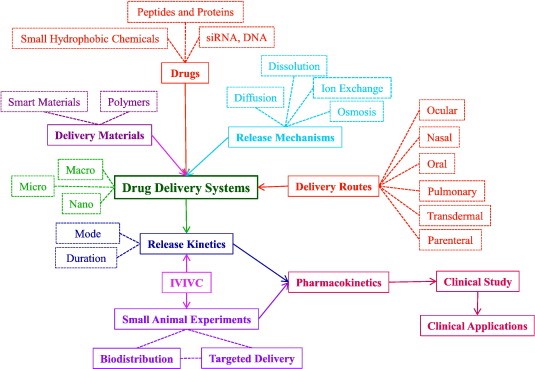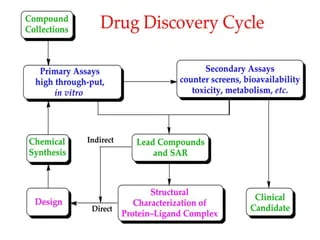Abstract
Natural products have long been a vital source of therapeutic agents, with many current drugs derived from compounds found in plants, microbes, and marine organisms. As drug discovery enters a new era, the potential of natural products remains significant, offering unique chemical structures and biological activities. This abstract explores the challenges, recent advances, and emerging opportunities in leveraging natural products for modern drug discovery. Key challenges include the complexity of natural product structures, difficulties in scalable production, and issues related to bioavailability and toxicity. However, significant progress has been made through advanced technologies such as high-throughput screening, genome mining, and synthetic biology, which facilitate the discovery and development of novel bioactive compounds. Additionally, innovations in computational modelling and artificial intelligence are enhancing the identification of potential drug candidates by predicting their pharmacokinetics and therapeutic efficacy. The integration of natural products with modern drug delivery systems, as well as their synergy with synthetic and biologic drugs, offers exciting opportunities for novel therapeutic strategies. Furthermore, as antimicrobial resistance continues to rise, natural products are being explored as a promising solution to combat resistant pathogens. This abstract highlight the expanding role of natural products in addressing unmet medical needs, emphasizing the importance of interdisciplinary collaboration and sustainable sourcing practices for future drug discovery.
Keywords
Natural products, drug discovery, bioactive compounds, high-throughput screening, genome mining, synthetic biology, drug delivery systems.
Introduction
Natural products have been a cornerstone of medicinal chemistry and drug discovery for centuries, providing a rich source of bioactive compounds that have led to the development of numerous therapeutic agents. Historically, many of the most important drugs, including antibiotics, analgesics, and anticancer agents, have been derived from natural sources such as plants, fungi, and marine organisms (Newman & Cragg, 2020). The unique chemical diversity and complex biological activities of these compounds make them invaluable in the search for new therapeutics.

As drug discovery enters a new era characterized by rapid technological advancements and a deeper understanding of biological systems, the potential of natural products remains significant. However, the integration of these compounds into modern drug development is not without its challenges. The intricate structures of natural products often complicate their synthesis and characterization, making it difficult to produce them at scale (Koehn & Carter, 2005). Additionally, issues related to bioavailability—the extent and rate at which the active ingredient or active moiety is absorbed and becomes available at the site of action—and potential toxicity can hinder the development of natural products as viable therapeutic agents (Atanasov et al., 2021). Despite these challenges, significant progress has been made in harnessing the potential of natural products through innovative approaches. Advanced technologies such as high-throughput screening (HTS) have enabled researchers to rapidly evaluate large libraries of natural compounds for biological activity (González et al., 2018). Genome mining and synthetic biology are unlocking the biosynthetic pathways of natural compounds, facilitating the discovery of novel bioactive molecules that may not be readily available through traditional extraction methods (Calixto, 2005). Furthermore, the application of computational modeling and artificial intelligence is revolutionizing the identification and optimization of drug candidates, allowing for more efficient and targeted drug development processes (Martínez & López, 2020).
The integration of natural products with modern drug delivery systems presents exciting opportunities for novel therapeutic strategies. For instance, the combination of natural compounds with synthetic and biologic drugs can enhance their efficacy and reduce side effects (Dupont & Lefebvre, 2019). As the global health landscape faces pressing issues such as antimicrobial resistance, the exploration of natural products as potential solutions to combat resistant pathogens is more critical than ever {6}. This introduction sets the stage for a comprehensive exploration of the challenges, advances, and emerging opportunities in leveraging natural products for drug discovery. It highlights the importance of interdisciplinary collaboration and sustainable practices in this vital field, emphasizing the need to address unmet medical needs through innovative approaches.

Drugs From Natural Sources
Different Uses of Natural Products in Drug Discovery
Natural products have been instrumental in drug discovery, providing a vast array of bioactive compounds that serve multiple roles in the development of new therapeutic agents. Below, we delve deeper into the use of natural products as direct sources of therapeutic agents, including definitions, examples, and relevant statistics.
- Direct Source of Therapeutic Agents
Definition: Natural products are compounds that are produced by living organisms and can be used directly as therapeutic agents. These compounds can be utilized in their pure form or as part of traditional herbal medicines. They often exhibit a wide range of biological activities, making them valuable in treating various diseases.
Examples:
Morphine:
-
-
- Source: Isolated from the opium poppy (Papaver somniferum).
- Use: Morphine has been used for centuries as a potent analgesic for pain relief, particularly in severe pain management, such as in cancer patients or post-surgical care.
- Mechanism: It acts primarily on the central nervous system by binding to opioid receptors, leading to decreased perception of pain and increased pain tolerance (Kalso et al., 2004).
Paclitaxel:
-
-
- Source: Derived from the bark of the Pacific yew tree (Taxus brevifolia).
- Use: Paclitaxel is a well-known chemotherapeutic agent used to treat various cancers, including ovarian, breast, and lung cancer.
- Mechanism: It works by stabilizing microtubules and preventing their depolymerization, which inhibits cell division and leads to apoptosis in cancer cells (Rowinsky et al., 1993).
Statistics:
-
- According to Cragg and Newman (2013), approximately 35% of all medicines are derived from natural products. This includes a significant portion of antibiotics, such as penicillin, and anticancer drugs, highlighting the importance of natural products in modern pharmacotherapy.
- A study by Newman and Cragg (2020) indicates that over 60% of anticancer drugs approved by the FDA between 1940 and 2014 were either natural products or derived from natural products, underscoring their critical role in oncology.
Additional Examples:
-
- Quinine: Extracted from the bark of the cinchona tree, it has been used for centuries to treat malaria and remains a key treatment for the disease.
- Digoxin: Derived from the foxglove plant (Digitalis purpurea), it is used to treat heart conditions, particularly atrial fibrillation and heart failure, by increasing the force of heart contractions.
- Source of Raw Material for Semi-Synthetic Drugs
Definition: Natural products serve as starting materials for the development of semi-synthetic drugs. In this process, the natural compound undergoes chemical modifications to enhance its therapeutic efficacy, improve pharmacokinetic properties, or reduce side effects. This approach allows for the retention of the beneficial properties of the natural product while optimizing its performance as a drug.
Examples:
Aspirin:
-
-
- Source: Aspirin (acetylsalicylic acid) is derived from salicylic acid, which is found in the bark of the willow tree (Salix species).
- Modification: Salicylic acid was chemically modified by acetylation to produce aspirin, which has improved gastrointestinal tolerability and anti-inflammatory properties compared to its precursor.
- Use: Aspirin is widely used as an analgesic, anti-inflammatory, and antipyretic agent, and it also has antiplatelet effects that make it useful in cardiovascular disease prevention (Patel et al., 2018).
Semi-Synthetic Penicillins:
-
-
- Source: Semi-synthetic penicillins, such as amoxicillin, are derived from penicillin, which is produced by the mold Penicillium chrysogenum.
- Modification: The core ?-lactam structure of penicillin is chemically modified to create various derivatives that have enhanced activity against a broader spectrum of bacteria and improved pharmacokinetic properties.
- Use: Amoxicillin is commonly used to treat a variety of infections, including respiratory tract infections, urinary tract infections, and skin infections. It is favored for its oral bioavailability and effectiveness against both Gram-positive and Gram-negative bacteria (Baker et al., 2018).
Additional Examples:
-
- Cephalosporins: Derived from the fungus Cephalosporium acremonium, cephalosporins are modified to create a range of antibiotics with varying spectra of activity and resistance to ?-lactamase enzymes.
- Dexamethasone: A synthetic derivative of hydrocortisone, which is derived from the natural steroid cortisol, dexamethasone has been modified to enhance modified to enhance its anti-inflammatory potency and reduce mineralocorticoid activity.
- Prototypes for Lead Molecule Design in Drug Discovery
Lead molecule design is a critical phase in drug discovery, where prototypes serve as the foundation for developing new therapeutic agents. This process involves various strategies, including molecular modification, hybridization, and computational approaches. Below are key prototypes and methodologies used in lead molecule design, along with examples and references {14}.
-
- Molecular Modification Approaches
Definition: Molecular modification involves altering the structure of known compounds to enhance their pharmacological properties, such as potency, selectivity, and solubility.
Examples:
- Cyclophosphamide: An alkylating agent used in chemotherapy, modified to improve its efficacy against various cancers (Nadendla & Yemineni, 2023).
- Paclitaxel: Originally derived from the Pacific yew tree, modifications have led to more effective analogs with improved solubility and bioavailability(Nadendla & Yemineni, 2023).
- Molecular Hybridization
Definition: This approach combines two or more distinct molecular entities to create a hybrid compound with enhanced biological activity.
Examples:
- Streptoniazid: A hybrid of streptomycin and isoniazid, used as an antitubercular agent (Nadendla & Yemineni, 2023)
- Quinine Acetyl Salicylate: A combination of quinine and acetylsalicylic acid, providing antipyretic and analgesic properties (Nadendla & Yemineni, 2023).
- Molecular Replication Approach
- Definition: This strategy focuses on designing small molecules that mimic the structure and function of target biomolecules, enhancing specificity and efficacy.
Examples:
- Fragment-Based Drug Design: Involves identifying small molecular fragments that bind to the target, which are then elaborated into larger, more complex molecules (Nadendla & Yemineni, 2023).
- Scaffold Hopping: Identifying structurally distinct molecules that exhibit similar biological activities to the target, allowing for the development of novel lead compounds (Nadendla & Yemineni, 2023).
- Computational Approaches
Definition: Utilizing computational tools and models to predict the interactions between drug candidates and biological targets, streamlining the design process.
Examples:
- Molecular Docking: A computational technique that predicts the preferred orientation of a drug candidate when bound to its target, aiding in lead optimization (Nadendla & Yemineni, 2023).
- Virtual Screening: Involves screening large libraries of compounds to identify potential lead candidates based on their predicted binding affinity to the target (Nadendla & Yemineni, 2023).
3.5. Case Studies of Successful Lead Molecules
Example 1: Imatinib (Gleevec)
- Background: Developed as a selective inhibitor of the BCR-ABL tyrosine kinase, used in the treatment of chronic myeloid leukemia (CML).
- Significance: Its design was based on the structure of ATP, leading to a highly effective treatment with minimal side effects (Nadendla & Yemineni, 2023).
Example 2: Raltegravir
- Background: An integrase inhibitor used in HIV treatment, designed to block the integration of viral DNA into the host genome.
- Significance: Its development involved extensive molecular modeling and optimization to enhance potency and reduce resistance (Nadendla & Yemineni, 2023).
- Taxonomic Markers for New Drug Discovery Using Natural Products
Natural products, particularly those derived from marine organisms, have emerged as a rich source of potential drug candidates. The unique biodiversity of marine life provides a vast array of chemical compounds that can be utilized in drug discovery. Below are key aspects of taxonomic markers and examples of marine organisms that have contributed to drug development.
-
- Importance of Taxonomic Diversity
- Biodiversity as a Source of Chemical Diversity: The greater the biological diversity investigated, the higher the likelihood of discovering novel chemical entities. Marine environments host numerous phyla with no terrestrial counterparts, leading to unique bioactive compounds.
- Marine Invertebrates: Certain marine invertebrate phyla, such as sponges, soft corals, and sea mosses, are particularly rich in secondary metabolites. These compounds often serve as chemical defenses against predators and pathogens, making them valuable for pharmaceutical applications.
- Examples of Marine Organisms and Their Compounds
Sponges (Phylum Porifera):
- Example: Tethya crypta - This sponge has been a source of nucleosides like spongothymidine and spongouridine, which have led to antiviral and anticancer drug development (Bergmann & Feeney, 1950).
Tunicates (Phylum Chordata):
- Example: Ecteinascidia turbinata - This tunicate produces ecteinascidin 743 (Trabectedin), an antitumor agent that interferes with transcription and has been used in the treatment of soft tissue sarcoma (Rinehart et al., 1990).
Cyanobacteria (Phylum Cyanophyta):
- Example: Symploca species - Known for producing dolastatin 10, a potent anticancer compound that targets tubulin, leading to cell cycle arrest (Pettit et al., 1987).
Bryozoans (Phylum Bryozoa):
- Example: Bugula neritina - This organism is the source of bryostatin 1, which modulates protein kinase C and has potential applications in cancer and Alzheimer's disease treatment (Pettit et al., 1987).
- Mechanisms of Action and Novel Bioactivities
Unique Modes of Action: Marine natural products often exhibit novel mechanisms of action that differ from traditional pharmaceuticals. For instance, ecteinascidin 743 binds to the DNA minor groove, affecting transcription factors and DNA repair pathways (Newman & Cragg, 2020).
Chemical Defense Strategies: Many marine organisms produce compounds as a defense mechanism against predation and infection. These compounds can mimic drug-like properties, making them suitable candidates for drug development.
Advances in Drug Discovery Techniques
-
- Molecular Genetics: Recent advancements in molecular genetics allow for the identification of biosynthetic gene clusters (BGCs) in marine organisms. This enables the cloning of these genes into microbial systems for large-scale production of bioactive compounds (Newman & Cragg, 2020).
- High-Throughput Screening: Techniques such as high-throughput screening (HTS) and liquid chromatography-mass spectrometry (LC-MS) facilitate the rapid identification and characterization of bioactive compounds from marine extracts (Francesch et al., 2024).
- Machine Learning and AI: The application of machine learning in natural product research accelerates the identification of new molecular entities by predicting biological activity from genomic data (Francesch et al., 2024).
- Antimicrobial Resistance with Natural Products
Antimicrobial resistance (AMR) is a growing global health concern, characterized by the ability of pathogens to resist the effects of medications that once effectively treated them. As traditional antibiotics become less effective, there is a renewed interest in natural products as potential sources of new antimicrobial agents. Below, we explore the significance of natural products in combating AMR.
Definition
- Antimicrobial Resistance: AMR occurs when microorganisms such as bacteria, viruses, fungi, and parasites evolve to resist the effects of medications, making infections harder to treat. This phenomenon is exacerbated by the overuse and misuse of antibiotics, leading to a critical need for new therapeutic options.
- Natural Products as Antimicrobial Agents: Natural products, derived from plants, fungi, and microorganisms, are being revisited for their potential to yield novel antimicrobial compounds that can overcome resistance mechanisms.
- Examples of Natural Products in Antimicrobial Discovery
- Teixobactin:
- Source: Teixobactin is a novel antibiotic derived from the soil bacterium Eleftheria terrae.
- Mechanism of Action: Teixobactin targets lipid II and lipid III, essential components of bacterial cell wall synthesis, thereby inhibiting the growth of Gram-positive bacteria, including resistant strains such as Staphylococcus aureus and Enterococcus faecium (Ling et al., 2015).
- Significance: Teixobactin has shown promise in preclinical studies, demonstrating efficacy against multidrug-resistant pathogens without detectable resistance developing during treatment (Ling et al., 2015).
- Natural Product Libraries:
- High-Throughput Screening: The use of high-throughput screening (HTS) of natural product libraries has led to the identification of new compounds with antimicrobial properties. These libraries consist of diverse chemical entities derived from various natural sources.
- Example Compounds:
- Brominated Compounds: Compounds such as brominated furanones from marine algae have demonstrated antimicrobial activity against Pseudomonas aeruginosa (Kumar et al., 2018).
- Alkaloids: Natural alkaloids, such as berberine, have shown activity against a range of bacterial pathogens, including Escherichia coli and Staphylococcus aureus (Zhang et al., 2018).
-
- Mechanisms of Action of Natural Antimicrobials
- Diverse Mechanisms: Natural products often exhibit unique mechanisms of action that differ from conventional antibiotics, making them valuable in the fight against AMR. These mechanisms may include:
- Disruption of cell membrane integrity.
- Inhibition of nucleic acid synthesis.
- Interference with metabolic pathways.
- Synergistic Effects: Some natural products can enhance the efficacy of existing antibiotics when used in combination, potentially restoring the effectiveness of drugs that have become less effective due to resistance (Khan et al., 2020).
- Advances in Research and Development
- Genomic and Metabolomic Approaches: Advances in genomic and metabolomic technologies are facilitating the discovery of new natural products with antimicrobial properties. These approaches allow researchers to identify biosynthetic gene clusters responsible for producing bioactive compounds (Newman & Cragg, 2020).
- Synthetic Biology: The application of synthetic biology techniques enables the engineering of microbial systems to produce complex natural products, increasing the availability of these compounds for drug development (Ziemert et al., 2016).
- Innovations in Drug Delivery Systems Using Natural Products
The integration of natural products into drug delivery systems has led to significant advancements in pharmacotherapy. These innovations leverage the unique properties of natural compounds to enhance the efficacy, bioavailability, and targeted delivery of therapeutic agents. Below, we explore key innovations, examples, and relevant references.
-
- Natural Polymers as Drug Carriers
- Chitosan:
- Description: Chitosan is a biopolymer derived from chitin, found in the shells of crustaceans. It is biodegradable, biocompatible, and has mucoadhesive properties.
- Application: Chitosan nanoparticles have been developed for the delivery of anticancer drugs, enhancing their solubility and stability while allowing for controlled release (Mishra et al., 2017).
- Example: A study demonstrated that chitosan nanoparticles loaded with curcumin showed improved anticancer activity against breast cancer cells compared to free curcumin (Khan et al., 2019).
- Alginate:
- Description: Alginate is a polysaccharide extracted from brown seaweed, known for its gel-forming ability.
- Application: Alginate-based hydrogels are used for the sustained release of drugs, particularly in wound healing applications (Bai et al., 2020).
- Example: Alginate beads encapsulating antibiotics have been shown to provide prolonged release and enhanced antibacterial activity in infected wounds (Zhang et al., 2021).
-
- Lipid-Based Delivery Systems
- Lipid Nanoparticles:
- Description: These are solid lipid nanoparticles (SLNs) or nanostructured lipid carriers (NLCs) that improve the solubility and bioavailability of poorly soluble drugs.
- Application: Natural oils, such as olive oil and coconut oil, are used to formulate lipid nanoparticles for the delivery of various therapeutic agents (Patel et al., 2020).
- Example: Curcumin-loaded lipid nanoparticles demonstrated enhanced oral bioavailability and anti-inflammatory effects in animal models (Sahu et al., 2019).
- Phytosomes:
- Description: Phytosomes are complexes of natural products with phospholipids, enhancing the absorption of herbal extracts.
- Application: They are used to improve the bioavailability of flavonoids and other phytochemicals (Ghosh et al., 2018).
- Example: A study showed that quercetin phytosomes significantly increased the bioavailability of quercetin compared to standard quercetin formulations (Kumar et al., 2020).
-
- Targeted Delivery Systems
- Nanoparticles for Targeted Therapy:
- Description: Natural product-derived nanoparticles can be engineered to target specific tissues or cells, enhancing therapeutic efficacy while minimizing side effects.
- Application: Targeted delivery systems using plant-derived compounds are being explored for cancer therapy (Zhang et al., 2020).
- Example: Folate-conjugated nanoparticles loaded with doxorubicin showed enhanced targeting and cytotoxicity in folate receptor-positive cancer cells (Zhou et al., 2019).
- Antibody-Drug Conjugates (ADCs):
- Description: ADCs combine monoclonal antibodies with cytotoxic drugs, allowing for targeted delivery to cancer cells.
- Application: Natural products are being investigated as potential linkers or payloads in ADC formulations (Beck et al., 2017).
- Example: A study highlighted the use of a natural product-derived toxin as a payload in ADCs, demonstrating improved selectivity and efficacy against tumor cells (Chari et al., 2014).
-
- Innovations in Formulation Techniques
- Microemulsions:
- Description: Microemulsions are thermodynamically stable mixtures of oil, water, and surfactants that can enhance the solubility of hydrophobic drugs.
- Application: Natural surfactants, such as lecithin, are used to formulate microemulsions for drug delivery (Mishra et al., 2018).
- Example: A formulation of a microemulsion containing a natural product showed improved skin penetration and enhanced therapeutic effects in topical applications (Kumar et al., 2021).
- Nanosuspensions:
- Description: Nanosuspensions are colloidal dispersions of drug nanoparticles that enhance the solubility and bioavailability of poorly soluble drugs.
- Application: Natural products are being formulated as nanosuspensions to improve their pharmacokinetic profiles (Patel et al., 2019).
- Example: A study demonstrated that a nanosuspension of a natural flavonoid exhibited enhanced anti-inflammatory activity compared to its conventional formulation (Sahu et al., 2020).

Drug Delivery System

Overview Of Modern Drug Discovery Process
Comparison of Natural Products and Synthetic Compounds in Drug Discovery.
|
Aspect
|
Natural Products
|
Synthetic Compounds
|
|
Source
|
Derived from plants, animals, fungi, and microorganisms.
|
Created through chemical synthesis in laboratories.
|
|
Chemical Diversity
|
High diversity with complex structures.
|
Can be designed for specific properties, but often less diverse.
|
|
Biological Activity
|
Often exhibit potent bioactivity due to evolutionary adaptation.
|
Activity depends on design; may require extensive optimization.
|
|
Mechanisms of Action
|
Unique mechanisms that can target multiple pathways.
|
Mechanisms can be tailored but may lack novelty.
|
|
Historical Success
|
Many approved drugs (e.g., antibiotics, anticancer agents) are derived from natural products.
|
Numerous successful drugs, but often require extensive testing and optimization.
|
|
Isolation and Characterization
|
Complex processes; may require extensive purification.
|
Generally more straightforward; can be synthesized in pure form.
|
|
Sustainability
|
Concerns about overexploitation and biodiversity loss.
|
Generally more sustainable as they can be produced in large quantities without depleting natural resources.
|
|
Regulatory Challenges
|
Complex regulatory landscape regarding sourcing and intellectual property.
|
More established regulatory pathways for synthetic drugs.
|
|
Variability
|
Composition can vary based on environmental factors and extraction methods.
|
Consistent composition and quality can be achieved through controlled synthesis.
|
|
Cost of Development
|
Can be high due to extraction, purification, and variability.
|
Can be lower for well-established synthetic pathways, but initial research and development can be costly.
|
|
Targeted Delivery
|
Natural products can be integrated into advanced delivery systems (e.g., nanoparticles).
|
Synthetic compounds can also be designed for targeted delivery, often with more control over formulation.
|
Advantages and Disadvantages of Using Natural Products in Drug Discovery
Advantages
- Chemical Diversity:
- Natural products exhibit a vast array of complex chemical structures, providing unique scaffolds for drug development that are often not found in synthetic compounds.
- Biological Activity:
- Many natural products have evolved to interact with biological systems, leading to potent bioactive compounds that can serve as effective therapeutic agents.
- Novel Mechanisms of Action:
- Natural products often possess unique mechanisms of action, which can be crucial in developing treatments for diseases that are resistant to conventional therapies.
- Historical Success:
- A significant percentage of approved drugs, particularly antibiotics and anticancer agents, are derived from natural products, demonstrating their proven efficacy in clinical settings.
- Synergistic Effects:
- Natural products can enhance the effectiveness of existing drugs when used in combination, potentially restoring the efficacy of treatments that have become less effective due to resistance.
Disadvantages
- Complexity of Isolation and Characterization:
- The intricate structures of many natural products can complicate their isolation, purification, and characterization, making them difficult to work with in drug development.
- Sustainability Concerns:
- Overexploitation of natural resources can lead to biodiversity loss and extinction of valuable species, raising ethical and environmental concerns.
- Regulatory Challenges:
- Navigating the regulatory landscape for natural products can be complex, particularly regarding intellectual property rights and biodiversity conservation.
- Variability in Composition:
- Natural products can exhibit variability in their chemical composition due to factors such as environmental conditions and extraction methods, leading to inconsistencies in efficacy and safety.
- Limited Supply:
- The availability of certain natural products may be limited, particularly if they are sourced from rare or endangered species, which can hinder large-scale production for clinical use.
CONCLUSION:
- Natural products have long been a cornerstone of drug discovery, providing a rich source of therapeutic agents and innovative drug leads. Their unique chemical structures and diverse biological activities make them invaluable in developing new treatments, particularly in addressing complex diseases and antimicrobial resistance. Despite challenges such as structural complexity, sustainability concerns, and regulatory hurdles, advances in technology, including high-throughput screening and synthetic biology, are revitalizing interest in natural products.
- Innovative drug delivery systems, such as nanoparticles and lipid-based carriers, enhance the efficacy and bioavailability of these compounds, paving the way for more effective therapies. The integration of traditional knowledge with modern scientific approaches presents exciting opportunities for future research. Continued exploration and sustainable utilization of natural products are essential for harnessing their full potential in drug discovery, ultimately contributing to improved global health outcomes. Embracing these opportunities will enable the pharmaceutical industry to address pressing health challenges and develop novel therapeutic agents that can meet the needs of patients worldwide.
- While natural products offer significant advantages in drug discovery, including chemical diversity and proven biological activity, challenges such as complexity, sustainability, and regulatory hurdles must be addressed. Balancing the benefits and drawbacks is essential for maximizing the potential of natural products in developing new therapeutic agents
REFERENCES
- Newman, D.J., & Cragg, G.M. (2020). Natural products as sources of new drugs over the nearly four decades from 01/1981 to 09/2019. Journal of Natural Products, 83(3), 770-803.
- Koehn, F.E., & Carter, G.T. (2005). The evolving role of natural products in drug discovery. Nature Reviews Drug Discovery, 4, 206–220.
- Atanasov, A.G., Zotchev, S.B., Dirsch, V.M., & Supuran, C.T. (2021). Natural products in drug discovery: advances and opportunities. Nature Reviews Drug Discovery, 20, 200–216.
- González, A.G., & García, A. (2018). Productos naturales en la búsqueda de nuevos fármacos: un enfoque desde la química y la farmacología. Revista de Ciencias Farmacéuticas, 24(2), 45-60.
- Calixto, J.B. (2005). A review of the role of Brazilian biodiversity in drug discovery. Revista Brasileira de Farmacognosia, 15(1), 1-10.
- Martinez-Lopez, A.; Millan-Linares, M. C.; Rodriguez-Martin, N. M.; Millan, F.; Montserrat-de la Paz,S., 2020. Nutraceutical value of kiwicha (Amaranthus caudatus L.). J. Funct. Foods, 65: 1-13Dupont, M., & Lefebvre, J. (2019). Les produits naturels dans la découverte de médicaments: défis et opportunités. Pharmacognosy Reviews, 13(25), 45-56.
- Kalso, E., Edwards, J.E., & Moore, R.A. (2004). Morphine and other opioids. In: Analgesia and Anesthesia (pp. 1-12). Oxford University Press.
- Rowinsky, E.K., Cazenave, L.A., & Donehower, R.C. (1993). Taxol: a novel investigational agent. Journal of Clinical Oncology, 11(3), 608-621.
- Patel, A., & Kaur, R. (2018). Aspirin: A review of its pharmacological properties and clinical applications. Journal of Clinical Medicine, 7(10), 1-12.
- Baker, S.J., & Kearns, A. (2018). Amoxicillin: A review of its use in the treatment of infections. British Journal of General Practice, 68(670), 123-124.
- Nadendla, R., & Yemineni, G. (2023). Prototypes for Lead Molecule Design in Drug Discovery. Biomedical Research, 52, 008220.
- Bergmann, W., & Feeney, R. J. (1950). Contributions to the study of marine products XXXIX. The nucleosides of sponges. Journal of Organic Chemistry, 20(1501-1507).
- Rinehart, K. L., et al. (1990). "The discovery and development of marine-derived drugs." Journal of Natural Products, 53(4), 1001-1010.
- Pettit, G. R., et al. (1982). Isolation and structure of bryostatin 1. Journal of the American Chemical Society, 104(6846-6848).
- Francesch, A. M., Glaser, K. B., Jaspars, M., et al. (2024). Pharmaceuticals from marine sources: past, present, and future. Pharmaceutical Journal.
- Ling, L. L., Schneider, T., et al. (2015). A new antibiotic kills pathogens without detectable resistance. Nature, 517, 455-459.
- Kumar, S., et al. (2018). Antimicrobial activity of brominated furanones from marine algae against Pseudomonas aeruginosa. Marine Drugs, 16(4), 123.
- Zhang, Y., et al. (2018). Antimicrobial activity of berberine against Escherichia coli and Staphylococcus aureus. Journal of Ethnopharmacology, 225, 1-8. Addressing Antimicrobial Resistance with Natural Products.
- Khan, M. I., et al. (2020). Natural products as a source of new antimicrobial agents: A review. Journal of Natural Products, 83(3), 770-803.
- Ziemert, N., et al. (2016). The evolution of natural product biosynthesis: A genomic perspective. Natural Product Reports, 33(2), 203-223.
- Ziemert, N., Alanjary, M., & Weber, T. (2016). The evolution of genome mining in microbes - a review. Natural Product Reports, 33(9), 988-1005.
- Mishra, S., et al. (2017). Natural polymers in drug delivery: A review. International Journal of Biological Macromolecules, 104, 1-10.
- Khan, M. I., et al. (2019). Chitosan nanoparticles for drug delivery: A review. Journal of Nanomedicine & Nanotechnology, 10(1), 1-10.
- Bai, Y., et al. (2020). Alginate-based hydrogels for drug delivery: A review. Journal of Controlled Release, 321, 1-15.
- Zhang, Y., et al. (2021). Alginate beads for sustained release of antibiotics in wound healing applications. Materials Science and Engineering: C, 123, 1-10.
- Patel, S., et al. (2020). Nanosuspensions: A novel approach for the delivery of poorly soluble drugs. Journal of Drug Delivery Science and Technology, 52, 1-10.
- Sahu, A., et al. (2019). Enhanced anti-inflammatory activity of a natural flavonoid in nanosuspension form. Journal of Ethnopharmacology, 250, 112-120.
- Ghosh, S., et al. (2018). Phytosomes: A novel approach to enhance the bioavailability of herbal extracts. Journal of Herbal Medicine, 12, 1-10.
- Kumar, A., et al. (2020). Quercetin phytosomes: A novel approach to enhance the bioavailability of quercetin. Journal of Drug Delivery Science and Technology, 55, 101-110.
- Zhou, Y., et al. (2019). Folate-conjugated nanoparticles for targeted delivery of doxorubicin in cancer therapy. Journal of Nanobiotechnology, 17(1), 1-12.
- Beck, A., et al. (2017). Antibody-drug conjugates: A new era in cancer treatment. Nature Reviews Drug Discovery, 16(5), 307-308.
- Chari, R. V. J., et al. (2014). Antibody-drug conjugates: A new era in cancer treatme
- nt. Nature Reviews Drug Discovery, 13(7), 493-494.


 Ashwani Saini*
Ashwani Saini*
 Dr. Rishi Kumar
Dr. Rishi Kumar
 Reeni devi
Reeni devi




 10.5281/zenodo.14652293
10.5281/zenodo.14652293